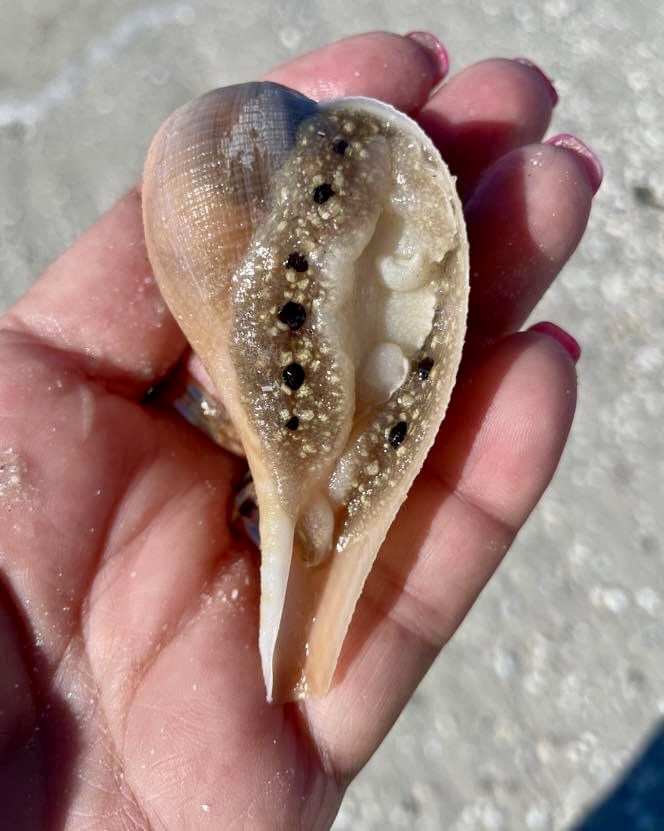Welcome, shell seekers! Prepare to dive deep into the captivating world of the Atlantic Fig Snail (Ficus papyratia), a Southwest Florida gem gracing our shores for millennia. As your local shelling expert and Florida Master Naturalist at Treasure Seekers Shell Tours, I’m thrilled to be your guide on this exploration of the Fig Snail’s scientific wonders, historical significance, and ecological importance.
A Masterpiece of Nature: The Atlantic Fig Snail
The Atlantic Fig Snail, boasting the scientific name Ficus papyratia, is a true testament to nature’s artistry. Its intricate shell patterns, resembling a fig or pear, and its delicate form make it a collector’s dream. This gastropod mollusk weaves itself into the vibrant tapestry of Southwest Florida’s marine life, contributing to the region’s rich biodiversity.
Habitat & Distribution: Unveiling the Fig Snail’s Sanctuary
Imagine gentle currents and swaying seagrass beds. These are the preferred havens of the Atlantic Fig Snail in Southwest Florida’s shallow coastal waters, particularly along sandy bottoms. These habitats provide a buffet of algae and detritus, the Fig Snail’s primary food source, alongside vital shelter from predators.
Nature’s Eternal Dance: Unveiling the Life Cycle
The Fig Snail’s life cycle follows a fascinating, age-old rhythm. These gastropods participate in external fertilization, releasing eggs and sperm into the water column. The fertilized eggs develop into larvae that drift for a period before settling on the ocean floor and maturing into the familiar fig-shaped adults we treasure.
A Delicate Appetite: The Fig Snail as Nature’s Gardener
As herbivores, Atlantic Fig Snails play a crucial role in maintaining a healthy marine ecosystem. They graze on algae and detritus, helping to control their growth and promoting a balanced underwater flora and fauna.
Where to Find the Elusive Fig Snail: Your Southwest Florida Shelling Adventure
Ready to hunt for these exquisite shells? Here are some prime locations to explore in Southwest Florida:
-
- Sanibel Island: Renowned for its biodiversity and pristine beaches, Sanibel offers ample opportunities to find Fig Snails. Explore the sandy shores, especially during low tide, and keep an eye out for these hidden treasures among the other seashell bounty.
-
- Captiva Island: Neighboring Sanibel, Captiva boasts similar shelling opportunities with a diverse range of marine life, including the Fig Snail. Wander the coastline, explore tidal pools, and keep your eyes peeled for these elusive shells.
-
- Marco Island: Venture further south to Marco Island’s beautiful beaches, where Fig Snails might be nestled in the sandy substrates. Take leisurely walks during low tide and let the treasures of the sea unveil themselves.
A Timeless Legacy: The Cultural and Historical Significance of Shells
Shells, like those of the Atlantic Fig Snail, have held immense cultural and practical value throughout history. Indigenous communities utilized them for ornamentation, crafting tools, and conducting ceremonial rituals. The intricate patterns and natural beauty of these shells made them prized possessions.
Fast forward to today, shells continue to inspire artists and artisans. The Fig Snail, with its distinctive shape and markings, serves as a timeless muse for creative expression, finding its way into art, crafts, and decorative objects.
Fig Snail Look-Alikes: Navigating the Sea of Shells
While the Atlantic Fig Snail boasts a distinctive shape, you might encounter similar species on your shelling adventures. Here’s a quick guide to differentiating them:
Florida Fighting Conch (Strombus pugilis): This larger conch shell has a flared lip and a pointed spire, unlike the Fig Snail’s smooth, rounded form.
Lettered Olive (Oliva sayana): This olive-shaped shell is much smaller than the Fig Snail and has a smooth, polished surface without the Fig Snail’s characteristic ridges.
Apple Murex (Phyllonotus pomum): This murex has a more spinose (thorny) exterior compared to the Fig Snail’s smooth shell. Additionally, the Apple Murex has a prominent siphonal canal (a long tube) absent on the Fig Snail.
Remember: When in doubt, leave it out! It’s always better to admire a shell in its natural habitat than risk harming the ecosystem by collecting an unidentified species.
Ethical Shelling Practices: Respecting the Seashell Symphony
The thrill of the hunt is undeniable, but responsible collecting is paramount to preserving the delicate balance of our marine environment. Here are some ethical shelling practices to keep in mind:
Size Matters: Only collect shells that are larger than the opening of your fist. This ensures smaller snails have a chance to reproduce and maintain healthy populations.
Live and Let Live: Always leave live mollusks behind. Their presence signifies a thriving ecosystem.
Respect the Habitat: Avoid turning over rocks or disturbing natural structures where mollusks reside.
Take Only Memories, Leave Only Footprints: Minimize your impact on the beach. Dispose of any trash you bring and leave the shoreline pristine for future shell enthusiasts. By following these guidelines, you can ensure your shelling adventures are sustainable and contribute to the conservation of our precious marine life. Remember, responsible collecting allows future generations to experience the wonder of the Atlantic Fig Snail and the countless other treasures our oceans hold.
Treasure Seekers Shell Tours: Visit our YouTube channel for a visual feast of shelling adventures in the Ten Thousand Islands. Get a glimpse into the wonders that await on our tours and gain a deeper understanding of the Atlantic Fig Snail and other coastal treasures. https://youtu.be/S3Cx8TnLQHg
Embark on a Shelling Odyssey with Treasure Seekers Shell Tours
The Atlantic Fig Snail, a symbol of timeless beauty and ecological significance, awaits your discovery. Join Treasure Seekers Shell Tours on an unforgettable shelling odyssey. We’ll unveil the secrets of these exquisite shells and celebrate the wonders of our marine ecosystem. Book your adventure today and let the treasures of the Ten Thousand Islands inspire you!
#AtlanticFigSnail #SouthwestFLShelling #TenThousandIslands #ShellingAdventure #FloridaShellingTours
